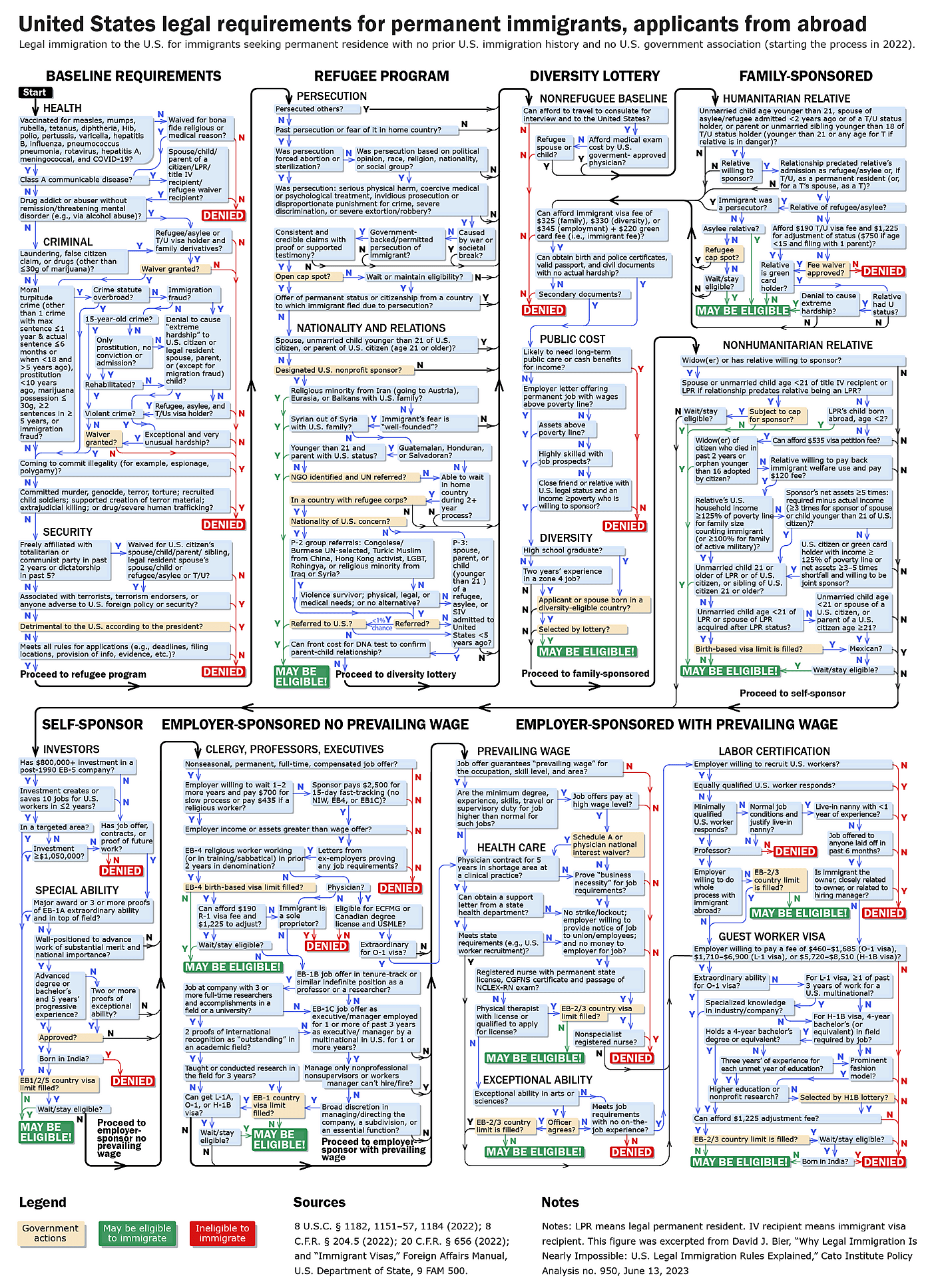David J. Bier
My latest policy analysis published today explains why it is impossible for nearly all immigrants seeking to come permanently to the United States to do so legally. The report is a uniquely comprehensive and jargon-free (to the extent possible) explanation of U.S. legal immigration. Contrary to public perception, immigrants cannot simply wait and get a green card (permanent residence) after a few years. Legal immigration is less like waiting in line and more like winning the lottery: it happens, but it is so rare that it is irrational to expect it in any individual case.
The figure below shows the U.S. legal immigration system for people who are abroad who presently intend to immigrate permanently to the United States. Below I briefly describe the main problems and choke points in this labyrinth.
Guilty Until Proven Innocent
Until the Immigration Act of 1924, everyone in the world was eligible to immigrate to the United States unless the government proved they fell into an ineligible category. In other words, innocent until proven guilty. Since then, the foundational principle of U.S. immigration law is that everyone in the world is ineligible to immigrate unless they prove to the government they fit into an eligible category. The result is that over 99 percent of all those wanting to immigrate to the United States cannot do so legally.
The Narrow Categories
Today, people must show they fit into one of five exceptions to the worldwide ban on immigration: 1) the refugee program, 2) the diversity lottery, 3) family sponsorship, 4) employment-based self-sponsorship, and 5) employer sponsorship. These categories are extraordinarily narrow. Few people can qualify, and thanks to low immigration caps, those who do qualify are often subject to decades-long waiting periods before they can enter legally.
1. The Refugee Program: the Lucky Few
The refugee program is supposed to provide a legal way to immigrate for people who fear return to their home countries. But the rules limit admission to those who fear return based on persecution by a government (or someone the government refuses to control), and only if the persecutor is motivated by someone’s race, religion, political opinion, nationality, or social group. More importantly, the program will only process refugees if they flee from their homes to a group of about 30 countries, and it will only accept applicants from about 30 countries.
Applicants usually need a referral from the United Nations, and they have a less than one percent chance of receiving such a referral. Moreover, the program has a cap, and the government has adopted processing procedures that make filling that cap extremely difficult. Barely one in 5,000 displaced persons will be admitted to the United States under the refugee program. The figure below shows the increasing number of displaced persons and the decreasing number of admissions under the refugee program.
2. The Diversity Lottery: the Golden Tickets
The diversity lottery has four basic rules: 1) applicants must show that they can support themselves at or above the poverty line, 2) applicants must have at least a high school degree or work experience in a job typically requiring a college degree, 3) only people from countries from which fewer than 50,000 people immigrated to the United States in the last five years can apply (excluding a majority of the world’s population), and 4) there are only 55,000 slots awarded through an annual lottery. The chances of winning the lottery and getting a green card have plummeted more than 90 percent since the first lottery was held in 1995.
3. Family Sponsorship: Only the Closest Relatives, Endless Waits
The biggest limitation on family sponsorship is having a qualifying sponsor. The family sponsorship is reserved primarily for the closest relatives: spouses and children of U.S. citizens and legal permanent residents as well as siblings and parents of adult U.S. citizens, and minor children and spouses of those relatives can join except in the case of parents, minor children, and spouses of U.S. citizens. The second limitation is the cap. Only spouses, minor children, and parents of adult U.S. citizens are uncapped, but their numbers reduce the cap of 480,000 for other relatives down to just 226,000. The result is a massive backlog of 8 million cases. For most countries and category combinations, sponsors will die before their relatives can immigrate.
4. Employment-Based Self-Sponsorship: Only for the Most Elite
Employment-based self-sponsorship is available only in the rarest set of circumstances. The three categories are for 1) people with “extraordinary ability,” 2) workers with advanced degrees or exceptional ability who are conducting activities of national importance, and 3) investors able to invest not less than $800,000 and—in some cases—more than $1.05 million in a business that creates 10 new jobs for U.S. workers within 2 years. These highly unusual cases apply to very few potential immigrants, but even in those cases, the government strictly enforces the criteria to make them as difficult to meet as possible. In 2019, for instance, the “extraordinary ability” category had a denial rate of over 40 percent.
5. Employer Sponsorship: Backlogs Wrapped in Red Tape
Employer sponsorship is the one chance where, in theory, it should be open to anyone with an employer sponsor in the United States. In practice, the procedures are so backlogged, so costly, and so time-consuming that very few employers are willing to attempt it except for the highest-paid workers in America. Aside from a few specific occupations, employers must advertise the job to U.S. workers. The process takes years, and even if no U.S. worker applies, very few employers can afford to keep a job open for such a prolonged period.
This is why nearly all employer-sponsored green cards go to people already in the United States who can start working on a temporary work visa, such as the H-1B visa, much sooner while they go through the lengthy green card process. But the H-1B visa is capped at just 85,000. The odds of winning the lottery and ultimately getting an H-1B visa were just 16 percent in 2022. But the even bigger problem for potential immigrants is that the H-1B visa requires a bachelor’s degree, and only 10 percent of the world’s population has a bachelor’s degree.
Even if you have a bachelor’s degree, win the lottery, and convince the employer to pay for the green card processing, the employment-based annual cap is massively oversubscribed. There was a backlog of about 1.4 million in 2020 for a cap of just 140,000. Because every country has the same cap, and immigrants from India account for half of all applicants, the backlog is overwhelmingly Indians who face a lifetime of waiting for a green card.
The U.S. Can Handle Much More Legal Immigration
The U.S. legal immigration system is restrictive in three ways. First, the system is restrictive compared with demand. Nearly 32 million people tried to receive a green card in 2018, while just 1 million were successful, and most could not even try the process. Second, the system is restrictive compared with U.S. history. In the decades prior to the 1920s, the United States routinely permitted a rate of legal immigration three to four times higher than 0.3 percent of the population permitted to receive a green card in recent years.
Finally, the system is restrictive compared with other countries. The United States ranks in the bottom third of wealthy countries for foreign-born share of the population. Even if it accepted 70 million immigrants tomorrow, it would still not surpass the likes of Australia.
Immigration benefits the United States, so there is no reason to place hard caps or strict categorical limits. Moreover, enforcing restrictive laws is costly and results in illegal immigration. The entire legal immigration system is actually designed not to be followed by most people, but to keep most people out. America should return to its system of openness that reflects U.S. traditions and benefits the country.
David J. Bier, “Why Legal Immigration Is Nearly Impossible: U.S. Legal Immigration Rules Explained,” Cato Institute Policy Analysis no. 950, June 13, 2023.
























